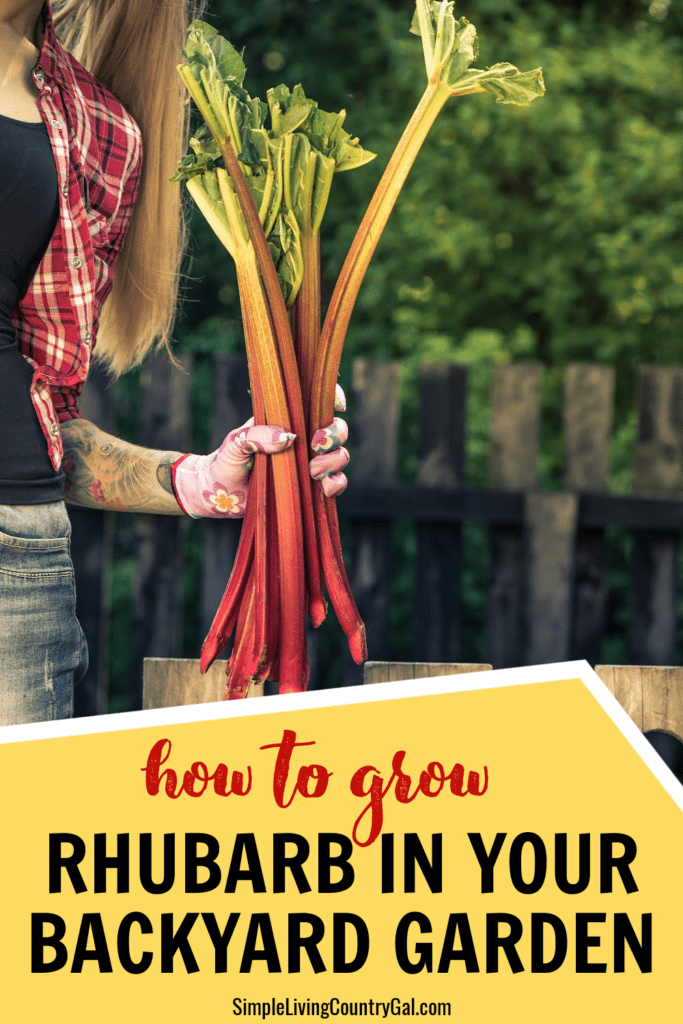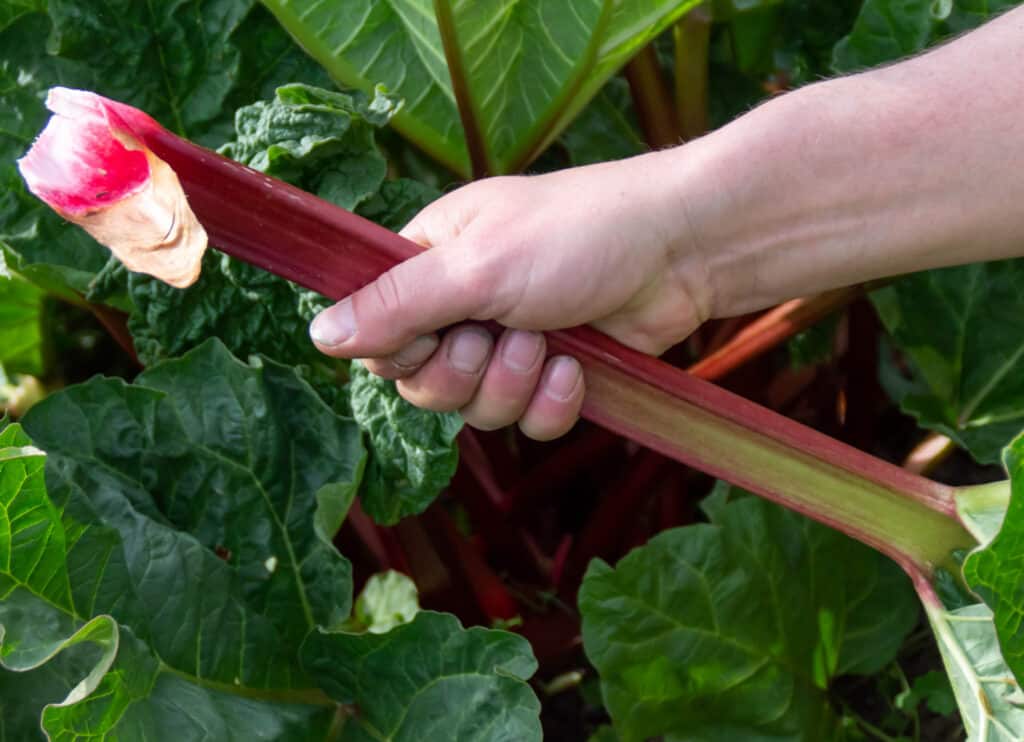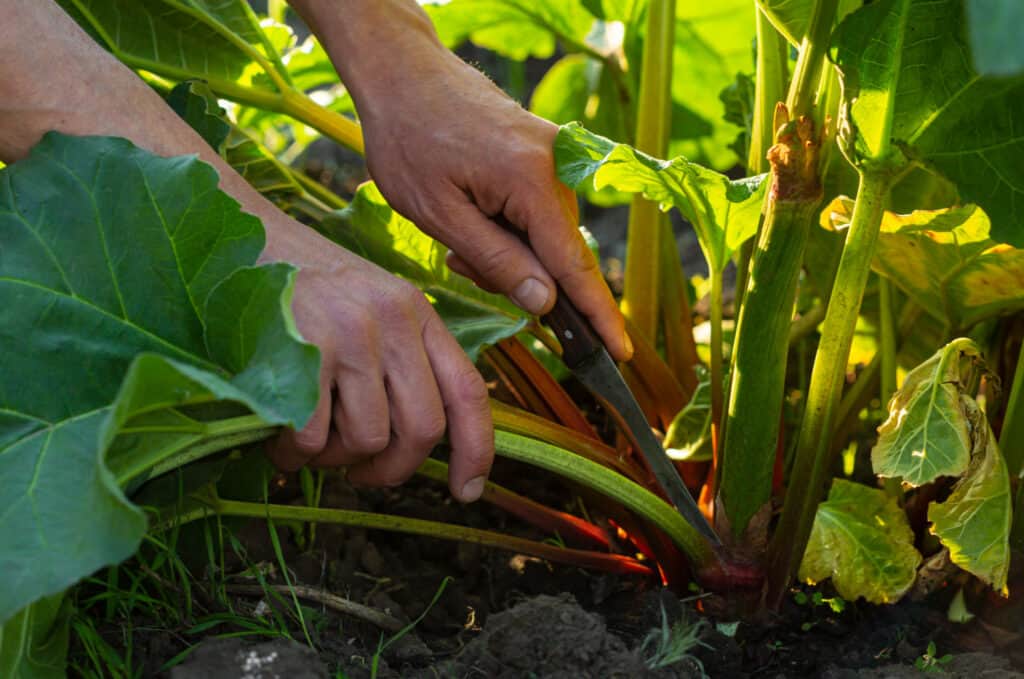How to Grow Rhubarb for Beginners
Get the steps from seed to table on How to Grow Rhubarb for Beginners. Add this amazing food to your backyard garden and enjoy a summer of Rhubarb desserts.
Gardening 101, is all about growing and this guide will get you off to a great start!

Rhubarb’s colorful stems offer a tart and tangy flavor perfect for pies and jams. The tartness is usually tamed with sugar or with the addition of strawberries. It provides plenty of sweetness to your summer.
Rhubarb has blocky stems and large leaves that add some visual texture to your garden. The leaves are not harvested, but do bring some lovely green to the rest of your garden. The leaves should not be eaten as they contain high levels of oxalic acid.
When harvesting, you’ll use the stems for eating but toss the leave or add them to your compost pile.

How to grow rhubarb for beginners
Rhubarb will grow best in areas that get cold enough for the ground to freeze in the winter. It requires an extended period of cold with temperatures below 40° F to produce a healthy harvest of stems. While primarily grown in areas with the coldest winters, it can be grown as far south as zone 7.
With its tart and tangy flavor, it’s commonly thought of as a fruit but rhubarb is actually a vegetable. It originated in Asia, was brought to Europe in the 1600’s, and made its way to America shortly after.
While it is easy to grow, it does require a dormant period to thrive. Fortunately though, it’s a perennial and will produce for five or more years after planting. For this reason, it should be planted in its own space in the garden where it can grow undisturbed by other plants. When planting, you’ll want to amend the soil with plenty of manure or compost. Some gardeners prefer to plant it near their compost pile.
A few varieties of rhubarb to consider include:
· Cherry Red
· Crimson Red
· MacDonald
· Victoria
· Canada Red
· Valentine
· Riverside Giant
Seed, Bulb, or Plant?
Rhubarb can be grown a variety of ways. You can grow it directly from seeds, from bare roots that you can find from online nurseries, or as full plants from nurseries that are dug up and divided.
The various methods will take anywhere from a short time to a much longer time to grow so it depends on when you plant and when you want to harvest. Regardless of the which method you use, the plants will need time to establish before you can harvest. With plants and bare roots, you’ll be able to harvest sparingly after the first year of growth. Each subsequent year will provide a larger harvest. When planting seeds, you’ll need 2-3 years for the plants to establish enough to grow for a harvest.
What You Need to Grow Rhubarb
When you’re ready to plant, choosing the right spot is crucial. You’ll need to choose a planting site that receives full sun. Partial shade is acceptable, but the more sun the better. You’ll also need well-draining and fertile soil. Providing plenty of drainage will keep your rhubarb from rotting. Rhubarb is a heavy feeder so you’ll also need organic matter to amend your soil.
When to Plant Rhubarb
Rhubarb does well when planted in the late fall or in early spring. If you want to plant in the fall, plant rhubarb crowns after dormancy has set. This will give you a spring harvest. If planting in the spring, plant the crowns as soon as the soil becomes workable and while the roots are still dormant; before any growth starts. Check the soil temperature and make sure it’s at least 50° F.
Temperature
Rhubarb prefers warmer temperatures to grow although it will lay dormant in colder temperatures and return when the soil warms up. Soil temperature should be at least 50° F before planting. Early to late spring is the best season for rhubarb but it will do well in summer too as long as it receives plenty of water.
Sun
Rhubarb does best in full sun for at least 6-8 hours per day. It will tolerate partial shade, but your harvest may be smaller.
Soil
Before planting, you’ll need to amend your soil with several inches of well-aged manure or compost to provide plenty of nutrients for the plants.
Water
Be sure to water your rhubarb well and consistently, it needs to be watered regularly until the soil is moist to an inch deep, especially in the hot days of summer.
Fertilizing
Each spring, fertilize the soil with 10-10-10 fertilizer once the ground has started thawing.
Support
Rhubarb grows close to the ground and has strong, hearty stalks so it does not require any kind of support system.
How Much to Plant
Since rhubarb isn’t a vegetable you’ll eat daily and it does grow back quickly once harvested, you’ll only need to plant 1 to 2 plants per person.
How Long Does Rhubarb Take to Grow?
How long it takes to grow depends entirely on how you plant it. If you’re planting seeds, it will take about 2 years before you can harvest and enjoy. From roots, you’ll be able to harvest it the year after you plant. And from a full plant, you should be able to get a small harvest the first year. Remember that it’s a perennial and will come back for up to 8 years so you’ll be able to keep enjoying it without replanting.
How to Plant Rhubarb
Depending on how you’re planting rhubarb, the planting method may vary slightly. If planting seeds, you’ll want to create holes about 12-18 inches deep and about 2-4 feet apart leaving about 3-4 feet between rows.
If planting crowns or full plants, which you can find in nurseries, garden centers, or online sources, they will already be growing in pots and you’ll simply need to transplant them to your garden. For this you’ll want to dig large holes, about the size of a bushel basket, and again keep them about 2-4 feet apart with 3-4 feet between rows.
Plant crowns so that they eyes are about 2 inches below the surface of the soil with the buds facing up. Full plants should be planted up to the base of the plant.
Before planting be sure to clear the site of any weeds or other debris. After planting, water well to saturate the soil.
Rhubarb Growing tips
Use these tips to ensure you are successful with your rhubarb garden. Things to watch out for so you can plant and grow huge amazing plants.
· Overcrowding is a common problem when growing rhubarb and it can decrease your harvest. To avoid this, split the roots every 3-4 years, dividing the plants when they are dormant in early spring or late fall. Each division should have at least one large bud.
· To help retain moisture, lay a heavy layer of mulch or straw over the soil. This will also help to reduce weeds.
· Water consistently and make sure the soil stays moist but don’t oversaturate it. It’s better to water more frequently with less than water than less frequently with a lot of water.
· Remove seed stalks as soon as they start to appear; they’ll drain energy from the plant growth.
· Before winter, remove any plant debris and cover the rhubarb with 2-4 inches of organic mulch once the ground freezes, preferably well-rotted compost. When you add nitrogen to the soil in the winter, it will prepare the rhubarb for a healthy growth in the spring.
· Not all rhubarb is red, the color of the stalks depends solely on the variety you plant. Just because your stalks don’t turn red doesn’t mean they’re unripe.
· Tall stalks with flowers are normal for mature plants but they can also appear when the weather becomes exceptionally hot or the rhubarb has been insufficiently watered or the plant is damaged. It’s best to cut and remove the flower stalks so the plant can recover and put all it’s energy into the stems.
How to Harvest Rhubarb
Rhubarb stalks are ready to harvest when they’re 7-15 inches long. Remember, the color is not an indicator of ripeness. Rhubarb can be harvested from spring until mid-summer then it’s best to stop harvesting so the plants can recuperate and store their energy for the winter. If the stalks become thin during the harvesting season, stop harvesting; this means the plant’s food reserves are running low.

Remember, the leaves can be toxic, only the stalks are edible.
Harvesting should not be done in the first year and only sparingly in the second year so that the plants can become properly established.
To harvest, grab the base of the stalk and pull it away from the plant by gently twisting it. You can also cut the stalk at the base with a sharp knife. If you’re cutting with a knife, sanitize it first to prevent the spread of any disease. Immediately discard the leaves.
When harvesting, always leave at least 2 stalks per plant to ensure their continued production and regrowth.
How to Store Rhubarb
Cut the rhubarb stalks and refrigerate them in a covered container or wrap them tightly in plastic wrap or foil and refrigerate them. It can be kept fresh in the refrigerator for a couple of weeks.
Rhubarb can also be frozen by cutting the stalks into pieces and placing them in a freezer-safe container or plastic bag. Rhubarb will last about a year in the freezer.
Diseases and Pests to Watch Out For
Like other fruits and vegetables in your garden, rhubarb is susceptible to some pests and diseases. A few to watch out for include:
· Gray Mold – creates yellow/brown/gray spots on leaves and flowers, the buds remain closed and stem lesions appear. Destroy any parts of plants or whole plants that become infected (do not compost) and remove any plant debris. Avoid overhead watering and create good air circulation.
· Crown and Root Rot – leaves become discolored and wilt, cankers appear near the base of the stems. Destroy any infected plants and the soil surrounding them (do not compost). Provide good air circulation and drainage, do not overwater.
· Fungal Leaf Spot – spots appear on lower leaves and turn brown or black. Fuzzy growth or pustules appear. Destroy any infected leaves or plants (do not compost) and remove any plant debris. Avoid overwatering. Some varieties are disease-resistant.
· Rhubarb Curcullo – a weevil-like beetle that bores into the stalks and crowns, and creates holes, leaking sap causing plants to wilt and decay. Handpick adults off they plants, they’ll appear in mid-May) and destroy any nearby host plants like sunflowers and thistle in mid-summer.
Organic Ways to Deter Garden Pests
· Slugs and Snails – they will create irregular holes in the leaves and leave behind a slimy secretion on the plants and soil. Young stems will completely disappear. Handpick them off the plants and avoid using thick bark mulch. Copper plant collars can help. Avoid overhead watering and lay boards on the soil in the evening.
Lift the boards and dispose of the pests in the morning by submerging in hot soapy water. You can also submerge in beer or a combination of sugar water and yeast. Applying a 1-inch-wide strip of diatomaceous earth will help deter them.
Rhubarb can be a very easy plant to grow if you’re willing to be patient. The first 2 years won’t provide much of a harvest, if any, but the next several years after that will produce a bountiful harvest, perfect for making delicious pies and jams.
I hope this article on how to grow rhubarb for beginners gives you the steps to add this wonderful plant to your garden.
